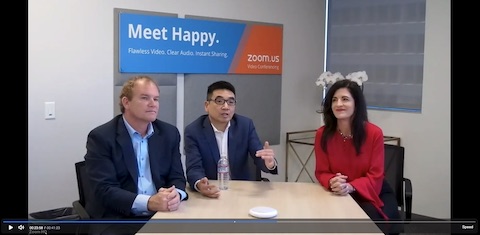The Zoom earnings call and the future of video communication
Zoom used its own video product to conduct its first post-IPO earnings call earlier in June. This is the future of communication.
As a former analyst, I can tell you what earnings calls used to be. There was a press release. Then there was a conference call, or possibly a Webinar. In any case, everything started with a canned presentation. At the end of the presentation, financial analysts asked pesky questions, most of which consisted of “can you add some color on” something, which meant they were going to recommend an appropriate valuation for the company to investors and needed to fill in some data (say, why international sales were flagging).
This was valuable information, but it was boring. So Zoom made it better.
The Zoom-enhanced earnings call
Zoom is a product that allows everyone to participate in a meeting. That’s not new — we’ve had Google Hangouts and competing products for a while. But the difference is that Zoom scales from one person with no video on a mobile phone to dozens sharing on video to hundreds or thousands on a Webinar to enabling video in every conference room in a company — and it all works together pretty well. That’s why I love it and use it with clients (and pay for it — even though I’m a pretty small business).
And in case you’re wondering, no, they haven’t paid me anything and I own no stock in the company. (The CEO did send me a cool backpack when I wrote something nice about them, but my perspective was positive well before that.)
Anyway, as Quartz described, Zoom’s conference call featured all the typical Zoom features. The executives presented from their conference room. You could see their faces (and crucially, their facial expressions), and then they shared a presentation on their screens. After that they talked to analysts. But you could see the analysts at their desks, and you could see the Zoom executives responding to their questions.
Same content, but a lot more human and a lot less boring.



The video communication future
We’ve been promised video calls since forever. I vividly recall trying out such a system at the Franklin Institute science museum in Philadelphia in the 1960s, and it’s in every science fiction movie from Blade Runner to Star Wars.
But now that every phone and every computer has a camera and Zoom has made it effortless to connect to it, things are about to shift. We’ll still do phone calls — but we’ll switch to video at a moment’s notice. And anything important, like a staff meeting or an earnings call, will be video enabled.
I’d like to believe this will make lying more difficult.
When you can see the executives on an earnings call telling you what they are hopeful or worried about, you can judge their veracity and certainty from the looks on their faces.
The same should be true in a sales call or a consulting call.
When I meet a new client, often remotely, I prefer to do it by video. I think my own sincerity comes across. And I get a feeling for just what they’re worried about.
And when I’m working with an author, I can better communicate what I’m after — and judge their reaction — when I can easily switch between content on my computer and a look at the author’s reaction.
I’m mastering this new medium, and I’m old. If I can do it, you can do it. And you’d better learn, because the next time you’re shuffling around madly and panicking on a call, we’re going to be able to see you.
While Zoom is great, please keep in mind that it may cause issues for some people, and they should not be penalized or made to feel bad about not being able to use the video portion. I have had to learn to “mute” all video when using Zoom because it messes with my vertigo. I’m sure there are others out there who also end up motion sick from using platforms like this as well.
I had no idea there were physical issues. Thanks for sharing that, Lori.